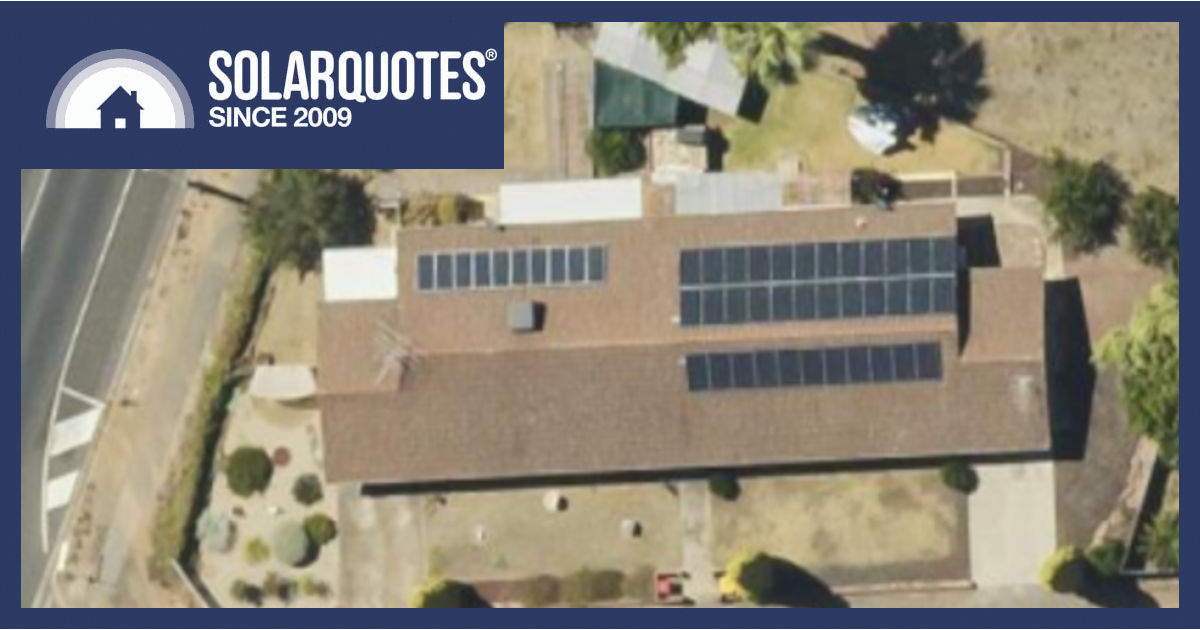
1.85kW left vs 10.85kW right
In Australia, the ideal solar panel orientation to maximise annual energy yield is north. If you’ve been holding back on solar power because your roof’s orientation is east, west or even south, it’s time to reconsider. Any solar is better than none in Australia, and with the advancements in technology and pricing, there’s no such thing as a “badly oriented” roof.
How Times Have Changed: Solar Panel Evolution
Back in the day, panel orientation and efficiency were crucial due to the high costs of solar panels. However, the dropping prices of solar systems and improved technology mean if your roof doesn’t face north, or is a weird pitch, you can cost-effectively just throw more panels at the problem.
Worst Solar Panel Direction In Melbourne Beats Best Direction In London
South-facing solar in Melbourne (the cloudiest capital city in Australia) is actually more effective than the same south-facing array in London.
That’s right, Londoners can have ideally placed solar panels and still not match a “misplaced” Melbournian array.
So even if you’re living under the clouds 180 days per year, the point is having more solar capacity on the roof is always better. When it’s overcast it doesn’t matter which way it’s facing, as long as it’s outdoors you’ll pick up something.
Running The Numbers
If we take the default 6.6kW system, face it south (azimuth 180°) on the standard 22.5° roof pitch and then drop it into PVWatts, you can see that London will yield 5,917 kWh/year versus 6,035 kWh/yearin Melbourne. Even in the pits of winter London makes 127kWh in December, while Melbourne makes 110kWh for June… facing the wrong way!
Spin that Melbourne array north and the coffee capital romps home with 8,918 kWh/year. There are losses on the south side in Melbourne – the short days and long shadows mean you’ll only generate 26% of a north-facing array when facing the “wrong” way; but that’s a lot better than zero. Who doesn’t want 26% more energy when you’re scratching for power to heat your home?
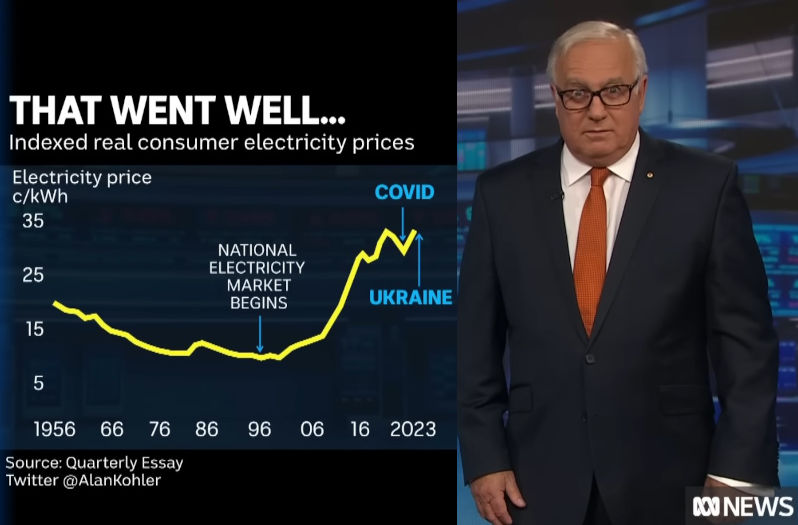
Alan looks like we all feel opening a power bill.
When Solar Panels Were 10X More Expensive
When solar panels were wholesaling at $5/watt and I was a limber little roof monkey carrying them up the ladder single-handedly, we really did make sure that panels were placed for the best yield. They simply had to face due north, and in a few cases we even installed tracking frames that chased the sun automatically.
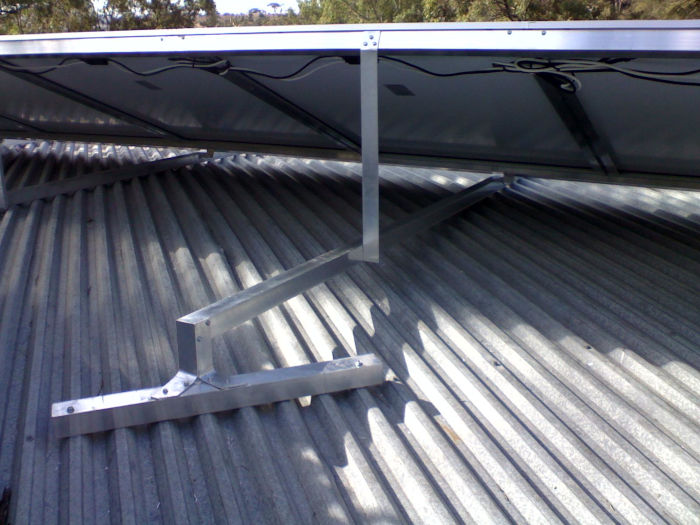
100-watt thin film panels, tilt frame, off-axis over a curved roof with limited purlins to screw into. Inventing and hand-making frames to point due North was fun in 2008.
When you only had 1kW of panels, it made sense to get the best from them because these systems retailed for 12 grand. In terms of energy, it was only ever going to average 4.4kWh each day, and those units were valuable when they paid 50c each on a premium feed-in tariff.
The mantra was perverse: export during the day and buy power back at night for half price, but that’s what was needed to get the early adopters to spend on new technology and establish a whole new industry in the process.
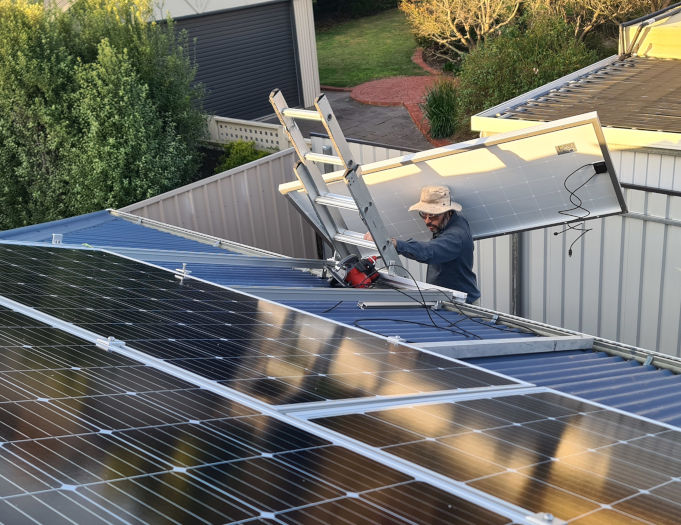
In 2023, I’m still carrying them up ladders, on the weekend, for fun.
How Does This Affect My Roof Now?
Solar is now so cheap it makes me sigh that I spent so much time building perfect reverse tilt arrays, angled off the roof axis. These days, you just throw more panels at the problem. It’s equal parts amazing and sad that efficiency is no longer a driver.
Solar PV is so cheap that Australians can afford to keep building rubbish houses and ameliorate the running costs by consuming more resources. It’s proving easier to rely on technology bolted to the roof than it is to actually design better houses.
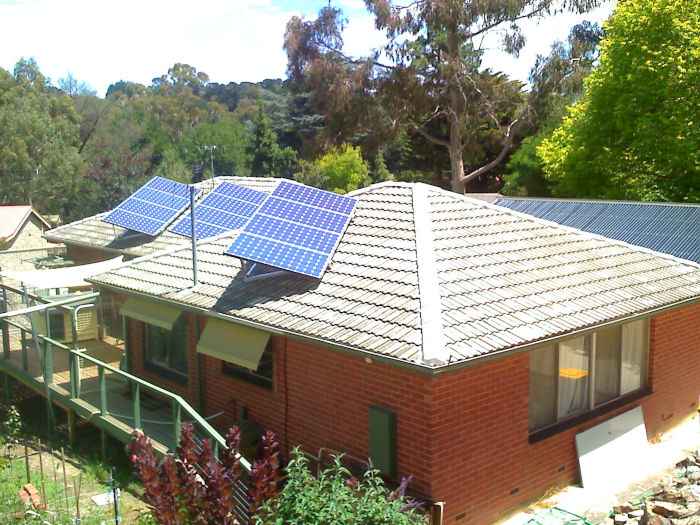
This customer didn’t own the trees that needed to be cut down, so we came at it another way. Vintage image credit: Solar Depot
Tilt Frames On South Roofs Mean Fewer Panels
Seeing as angled frames create long shadows, you’ll usually get only one row on a south-facing roof, where three rows of panels will fit if they’re laid flush.
Tilt Frames On Flat Roofs Can Mean More Panels
But flush isn’t always best. East/west tilt frames on flat roofs can fit more panels and save on panel cleaning.
Be Wary Of Tilt Frames On Tiles
Conventional tile roof hooks are designed to have a tile lapped over the top so they’re mechanically waterproof, but this means they inevitably have some flex in them. It doesn’t really matter when the solar panel array is parallel to the roof, but having tilt frames means there’s a big sail to catch the wind and a lot of potential for rattling and even broken tiles.
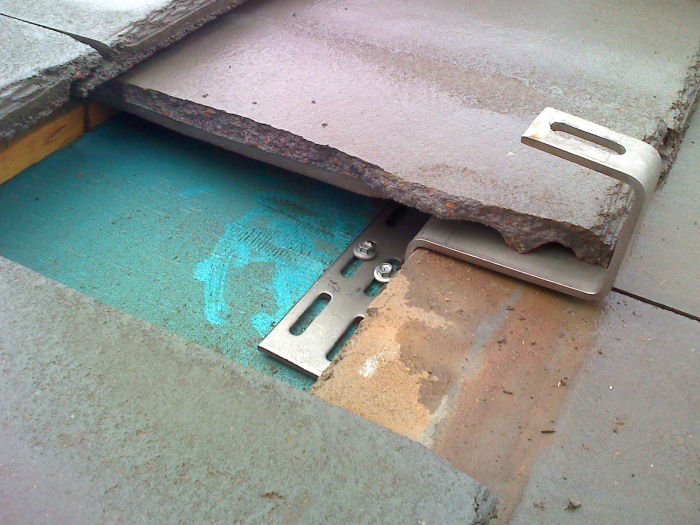
This tile split lengthwise when it was stepped on, but it shows how a typical tile hook lays. If there’s trouble, typically it’s the tile under the bracket under that cracks and leaks.
Using hangar bolts is a much sturdier way of doing it, but they must be screwed into the rafters, which means you’ll seldom get through the ideal part of a tile. Instead, you’ll have dozens of holes relying on silicone sealant, not gravity, to prevent leaks.
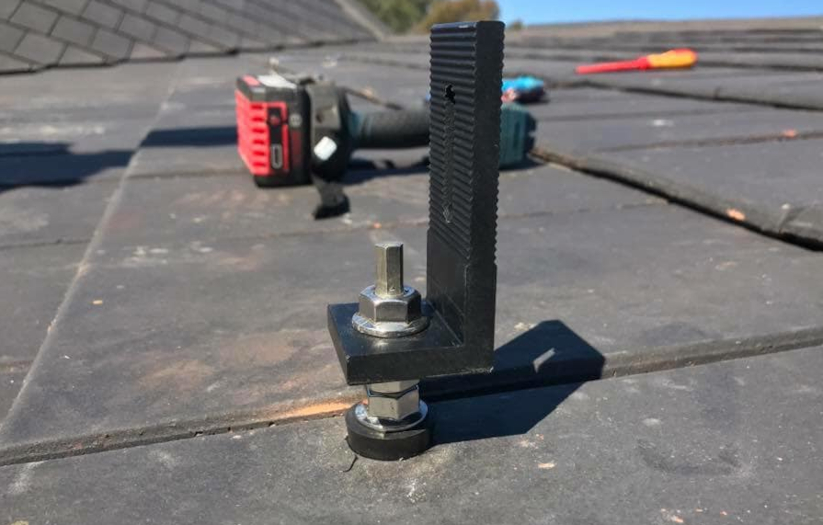
Hangar bolts are the only option on some roofs such as slate or really flat shingles.
The Real Use-Case For Microinverters Or Optimisers
With the trend to needlessly complex roof lines, the literal rise of small 2-storey townhouses, juxtaposed with increasing solar panel sizes, installs are becoming tricky. In many instances, having any solar at all means you have to resort to a series of one, two or three-panel arrays.
For these cases, Enphase microinverters (or maybe SolarEdge and Huawei optimisers) really come into their own because conventional solar inverters don’t work with short low-voltage strings of panels.
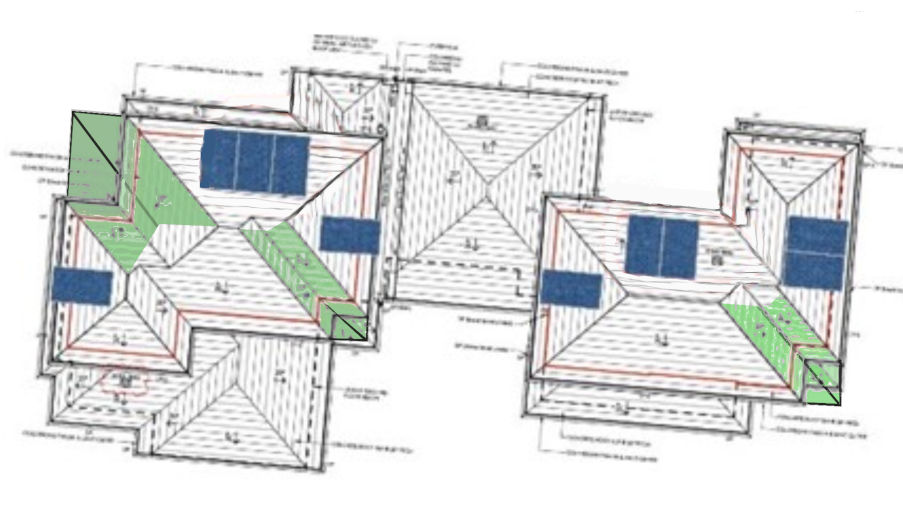
Using the south sides of these two townhouses would add some more capacity. Best approach is to straighten the roof line into an L shape (fill the green sections) and more than double the useful space.
West Is The New North, South Is The New Black
Using batteries to store electricity might be trendy, but using your own energy whenever it’s available makes most sense. As we move forward and Time Of Use electricity pricing becomes the standard, you’ll find that after 3pm (when the price of power triples at my place) it makes perfect sense to keep generating as long as you can with west-facing solar panels.
SQ’s feed-in-tariff comparison tool reveals that the Energy Locals’ Tesla Energy Plan in NSW will pay you a 30-cent feed-in tariff after 2 pm 1.
So while west is even better than north these days, having southern solar for summer will still make hot afternoons more bearable, with extra shade on your roof and extra energy to run the air conditioning.
Footnotes
- Requires a Tesla Powerwall battery to be eligible. ↩

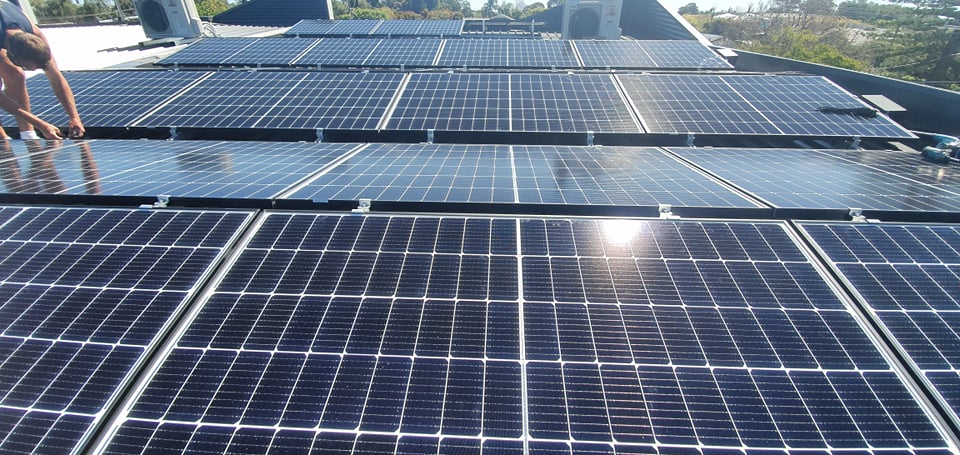
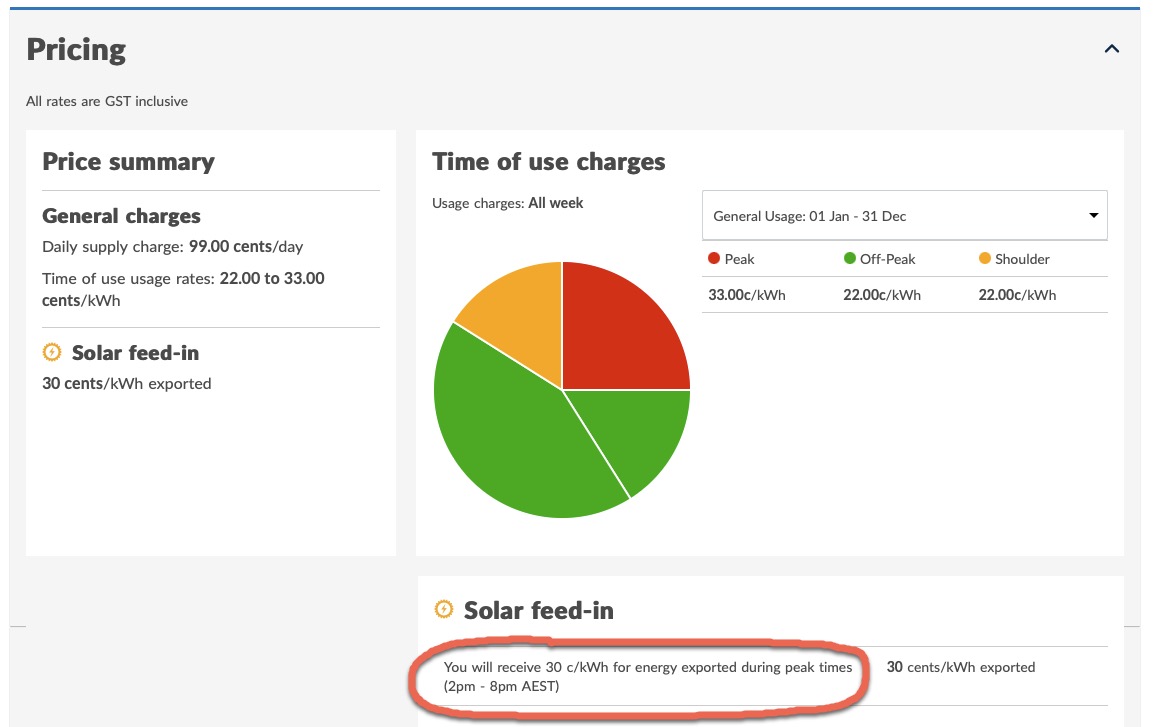
 RSS - Posts
RSS - Posts



Hugely entertaining article, thank you. And hadn’t seen that Energy Locals plan, will check that out.
I did see some research on the use of mirrors to boost performance on shaded roofs, apparently a very successful and inexpensive approach i.e.have them reflect low winter sun onto south-facing panels, for example. Apparently it can also lead to the need for fewer panels, as it ‘overclocks’ panels too, forcing them to produce more output. Probably over-engineering as a solution, but ‘concentrated PV’ is apparently an active research area:
https://link.springer.com/chapter/10.1007/978-981-19-7971-2_62#:~:text=Low%20fee%20reflecting%20mirrors%2C%20lenses,the%20solar%20module%20will%20increases.
I see anything but a north facing panel as a second choice and not desirable. I have a 10kW system north facing plus another 10kW system east/west split 60% west and 40% east. I can now compare real data!
East/West yield is about 75% of my north facing one.
There is no way i can compensate this drop by saving a bit more during the morning or afternoon.
Maybe once we get a time dependant feedin tariff. But then they will just screw us by not paying anything over midday. The big ones always win. Unfortunately.
I think that Energy Locals rate may be the Tesla Virtual Power Plant? Energy Locals is the retailer for Tesla’s VPP.
How do folk get onto Energy Locals’ Tesla Energy Plan? I was curious to look at the fine print, but cannot see anything on their website.
A look on the EL site reveals only 2 options – an Online Member + 6 Months Free Membership for $98 per month, and a Local Member for $110 per month – costs will vary slightly depending on the address you enter. Neither plan mentions Tesla, and the FiT offered is 11.5c/kWh capped at the first 10kW per day, and 6.2 c/kWh thereafter.
Going in a different way to look at rates forces an online member v local member v business member decision, the aforementioned low and capped FiT, plus a wide range of charge options – single rate, controlled loads, time of use, seasonal, demand, and assorted combinations thereof.
…
Okay used Duck rather than the EL site and found: https://save.energylocals.com.au/teslaenergyplan-tou/
Am I correct in concluding that all energy generated before 2pm is simply donated? As of 1:30 pm I’ve exported slightly under 30 kWh – it’s really not a good day. That’s roughly 3x the best I can generate from 2-8 pm while the EL rate for 2-8 is about 6x my rate. Today it might offer a slight advantage, but not a great one, and on sunnier days might actually cost money when factoring in the capped bonus rate FiT. And since your export window is sooo much narrower, non-sunny weather may be a far greater problem.
So the plan sounds good, but breaks down upon scrutiny. Am I overlooking anything?
Yes, anything prior to 2pm is donated for free.
But I think it’s a great plan, considering I have two EVs that can soak up the morning generation.
Why is it so difficult, Impissible to get add on solar panels. I’m in Prospect, Sydney.
Hi Geoff,
Have you tried putting some details in for quotes and had no luck? We have a few explainers but if you’re keen let us know and we’ll try to help.
https://support.solarquotes.com.au/hc/en-us/articles/360001755676-Summary-of-Rules-for-Solar-Additions-Alterations-Repairs-Upgrades
https://support.solarquotes.com.au/hc/en-us/articles/6181953301263-My-old-inverter-died-but-why-won-t-they-give-me-a-warranty-on-a-new-one-
https://support.solarquotes.com.au/hc/en-us/articles/360000204135-If-someone-else-other-than-the-original-installer-touches-my-solar-system-who-is-responsible-for-the-warranty-of-the-whole-system-
Yes, PVwatts shows that a 10 kW north facing array tilted at 40 degrees should give me 24 kWh/day in july, while another on the 14 degree tilted south skillion should give an additional 8.7 kWh/day. But instead putting the second array on a 7 degree west facing roof (on an adjacent building) should yield 15 kWh/day. Now it comes down to either clamp mounting on the new KlipLok roof or higher yield on a 50 year old corrugated iron roof, with a bunch of new roof penetrations. (Or just go for all 3 arrays? After all, as you imply (and my brother oft repeats); you can’t have too big an array in overcast. That matters off-grid, if the genset is to be avoided.)
That southern array is dynamite in summer, yielding 39 kWh/day if I read PVwatts correctly. I might have to hold car charging parties.
I wish someone would do a solar install on my roof!?
I have had 3 companies back out, because of the mainly south facing roofline.. If you know of any companies that would tackle a 2 story townhouse with awkward roof, let me know! 🙂
Hi Pete,
Let us know where you are and add some notes at the end of your application via the home page… we’ll endeavour to find a good installer. It’s usually the ones who are interested in the oddball stuff that do the nicest work in my experience.
Great article thanks.
South facing arrays actually make a huge amount of sense in Queensland, especially for self consumption which is what matters these days with typically minimal feed in tariffs.
Winter- reasonable power output but we use very little anyway. There is no need for heating here 99% of the time!
Summer- the aircon gets worked pretty hard and that’s when a South facing array really shines- plenty at midday but significantly MORE early morning and late afternoon.
It’s amazing how many people are totally unaware of that.
Incidentally I have friends with very old, (early 2010) basically identical systems, with one facing North and the other split East and West due to house and roof orientation. Over their lifetime the difference in production has been surprisingly little, with significantly less than 20% difference between the two.
I have 16 panels facing NNW, and 9 facing WSW, on a 17 deg pitch roof in Canberra.
– In summer they perform exactly the same: 2.8 kWh a day.
– In June, the NNW panels make 1.50 kWh an day, but the WSW panels only 0.75 kWh a day.
So direction makes a big difference, but the point is that both sets of panels are at such a reduced output in winter that the WSW panels’ reduced-reduced performance is then relatively inconsequential.
I track the economics of adding extra panels. One extra on the NNW pitch would make $49 a year, and one extra on the WSW pitch would make $39 a year. Not a lot of difference, and in any case not sure I want to invest to mainly just add more export power anyway.
Hi Michael, Your 2.8KWh output per day, is that per individual panel?
Yes, per 400 W Hyundai Green Energy panel each equipped with a Enphase microinverter
I’m actually finding so difficult to understand if I’m about to be ripped off for my potential $9000 install on a townhouse with a lot of shading. I’ve had feed in tariffs on a previous house and it’s just not worth it and I’m worried that I will not get any system that will do the job I want. Basically, I want to replace my gas instant hot water system with an electric but do not have enough roof space to place the necessary system on the roof. I also want to be able to generate enough power to reduce my electricity bill. Is there an independent body that I can pay to come and examine options for my townhouse as really do not trust the many claims made by those who have quoted.
Thanks for all your articles.
A house behind me has recently had two sets of panels fitted, one facing east, one facing north, the east ones will easily out perform the north ones, why? Because the north ones are fitted under the shade of a very large gum tree in my back yard and are in shade about 90% of the time.
Go figure….
I’ve applied to SolarQuotes to get extra solar installed based on this article. I’m sure I said I was looking at solar for the east and south roof facing. (call me out if Im wrong!).
Installer 1 – States that two inverters arent allowed on my Ausgrid 3 phase home but they’ll happily throw out my old system for a new one. Also recommended no south facing panels due to roof pitch (est 30degrees).
Installer 2 – Really pushed an Alpha ESS battery no matter how much I attempted to steer them away. Did promise to quote for ~4kw of east facing panels though they insisted it’d be as expensive as a battery. Looked at me like I had two heads when I mentioned south facing panels.
Installer 3 – Paid you for the referral I guess? 🙂
Thanks for the interesting article. A couple of queries –
My system has been upgraded a couple of times – now 3 single phase, dual MPPT’s, Huawei 5kW inverters on 3 phase system, with a few sizes of PV panels. (I went for single phase as I could buy progressively, and most importantly, I have 6 MPPT’s).
Systems #1/#2 – each with 10x250w (2500w) facing West (I reused the old system panels) plus newer 11x350w (3850w) facing East, so 6350w each.
System #3 – 8x415w=3320w facing West plus 8x415w=3320w facing East, so 6640w.
I’m still paying for some import so I’m thinking of a battery + upgrade. Huawei allow these battery ready inverters to have approx 10kW of panels if a Luna battery is connected. The limiting factor is basically the Voc and Imp for each string.
Roof space is becoming scarce. I have to buy some new panels for the 6.6 to 10kW upgrade, so maybe it’s time to drop the old 250w panels and use all new ~450w rated to gain near double the watts/sqM of roof. This way, I should with a little rearranging, be able to fit the extra ~3.5kW capacity for the battery inverter into the existing footprint. (If I can get someone to install PV on the insulated panel patio style roof, I could reuse the 250w panels on a fourth inverter, even the original one. It’s what installation cost to gain a 5kW system).
*Question – am I better with ALL panels facing East (or West), or half East, half West?
My thinking is –
1. East/West would give overall more hours of some input, rather than a big peak in the morning (or afternoon) and,
2. East/West would give longer hours charging the battery to assist with evening peak particularly.
The answer will set the positioning of the highest rated panels into the best sun locations available, and the lowest rated to the least sunny. Some areas get shaded later in the day.
Question – Does a three phase inverter with battery provide battery power to the three phases?
Thanks
Hi Roy,
Sounds like fun. A 3ph battery inverter will power a 3ph load without the grid, catch is that generally they have a lower surge capacity for single phase loads.
https://www.solarquotes.com.au/blog/solar-flat-roof-east-west-tilts/
More info :
https://www.solarquotes.com.au/panels/angle/
https://www.solarquotes.com.au/blog/solar-panel-tilt-frames-are-they-worth-it/
Electrical configuration for multiple directions isn’t too difficult either.
https://support.solarquotes.com.au/hc/en-us/articles/6080551391375-Can-we-have-solar-facing-three-directions-with-only-two-inverter-input-channels-
https://www.fronius.com/~/downloads/Solar%20Energy/Technical%20Articles/SE_TA_Efficient_East_West_orientated_PV_systems_with_one_MPP_Tracker_EN.pdf
https://www.fronius.com/~/downloads/Solar%20Energy/Whitepaper/SE_WP_The_SuperFlex_Design_of_the_Fronius_Symo_inverter_series_EN_AU.pdf
Thanks Anthony, very informative, paticularly the “white paper”.
.
I queried Huawei, (who have been very helpful with my many queries as I investigate various combinations), and their reply was a little surprising or maybe just conservative? –
Hi Roy,
We don’t have a figure for the maximum string voltage difference across two different MPPTs. However, we will recommend to have the voltage values as close as possible. (reply to a different question – R)
Also, we don’t recommend parallel connections of PV strings feed in our inverter. Our inverter only support one string of PV connected in series for each MPPT.
Best Regards,
Wenkun Li (Kun)
李文坤
Australia Office
HUAWEI TECHNOLOGIES (AUSTRALIA) PTY LTD
Also –
Can you tell me the situation with claiming REC’s for PV panels if you went the East/West parrallel sting path, and potentially a maximum of 260% of nominal inverter capacity? – I guess they are only applicable to the 130% and if so financially a no go. Better another inverter.
Regards
Roy
No worries Roy,
Interesting about Huawei. DO you recall the current specification of their MPPT? I know they offer optional optimisers so they may not play nicely in parallel?
As for STC incentives, your inverter can be 75% of the array capacity (133% overdriven) unless you have a battery hybrid, in which case full manufacturer capacity applies which might be 150% on Fronius 200% for Sungrow/GoodWe or even 300% if you have a very particular SolarEdge system.
Cheers
ENERGY COMPANIES REFUSING TO PAY FEED IN TARRIFS – DISCOURAGING SOLAR ADOPTION
I was recently about to install solar panels on my shaded townhouse in Byron Bay, however Essential Energy refused the application for feed in tariffs. As I cannot afford a battery, this made solar panel installation totally uneconomic.
It’s very disappointing given the need to quickly move to sustainable energy and it’s something that government will need to address.
Hi Tony,
I would try and redo your numbers and see what loads you can shift to the daytime, solar is all about generating your own energy and using it behind the meter. As we move forward more states are following SAPN’s lead and moving to flexible exports connections, so you can have more export 98% of the time, however the feed in tariffs paid shouldn’t be the financial figure on which your payback hinges.
Hi Anthony,
Thanks. Specs of MPPT’s below.
I’m not using optimisers atm and they are aware of my setup. I asked them to review my battery/upgrade to 10kW proposal, and no mention has been made of using optimisers although the Specs note 2 below mentions them for 10kW input. I can have (with Huawei Luna battery), approx 200% Huawei rating (so 10kW on my 5ktl) depending on the maximums wrt Voc and Isc. 🙂
I probably don’t need to go with strings in parallel, but my setup is ideal for that and may have saved me the cost of one inverter. The PV panel combinations capability with total of 6xMPPT’s is probably worth more to me.
MPPT Specs –
Recommended max. PV power *note 2 – 7,500 Wp/9,000 Wp (5ktl/6ktl)
Max. input voltage 600 V *note3
Start-up voltage 100 V
MPPT operating voltage range 90 V – 560 V *note 3
Rated input voltage 360 V
Max. input current per MPPT 12.5 A
Max. short-circuit current 18 A
Number of MPP trackers 2
Max. number of inputs 2
*note 2 – Inverter max input PV power is 10,000 Wp when long strings are designed and fully connected with SUN2000-450W-P power optimizers
*note 3 – The maximum input voltage and operating voltage upper limit will be reduced to 495 V when inverter connects and works with LG battery
Regards
Roy